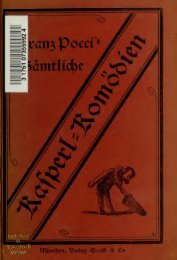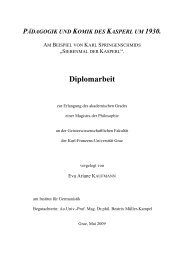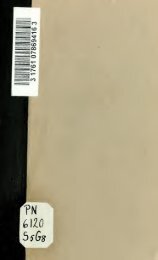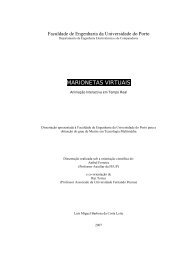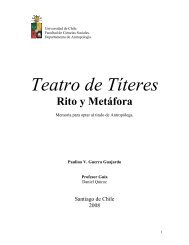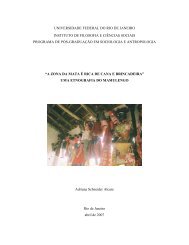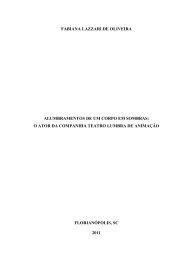ABSTRACT Title of Dissertation: THE PHENOMENOLOGY OF ...
ABSTRACT Title of Dissertation: THE PHENOMENOLOGY OF ...
ABSTRACT Title of Dissertation: THE PHENOMENOLOGY OF ...
Create successful ePaper yourself
Turn your PDF publications into a flip-book with our unique Google optimized e-Paper software.
Walter E. Deaves<br />
Edwin Deaves, Walter’s son, described a family tradition <strong>of</strong> puppetry, beginning<br />
with his grandfather. 76 In 1819, at the ripe age <strong>of</strong> ten, the also-named Edwin Deaves saw<br />
a Boston puppet company, and spent the remainder <strong>of</strong> his life working as a traveling<br />
puppeteer. An important highlight <strong>of</strong> the family legend occurs around 1840, when<br />
Deaves introduced puppetry to a performance by the Virginia Minstrels. 77 The<br />
connection to Deaves would lead to a significant transformation <strong>of</strong> the eidos <strong>of</strong> blackface<br />
puppetry, filtered through his son, Walter, and the subsequent work <strong>of</strong> Daniel Meader.<br />
While Deaves was in San Francisco, he met McDonough, and reportedly assisted<br />
him with production improvements. The seasoned puppeteer had much insight into the<br />
logistics <strong>of</strong> frontier production. 78 The most important result <strong>of</strong> their interaction was that a<br />
twenty-year-old Walter E. Deaves, Edwin’s son, joined the McDonough company.<br />
Though by 1875 he had set out on his own, Deaves helped transform the eidos <strong>of</strong><br />
blackface puppetry by introducing a less exaggerated, more sentimentalized frontality <strong>of</strong><br />
blackface than that produced by Bullock/D’Arc.<br />
Edwin’s proximity to the Virginia Minstrels seems to have deepened Walter’s<br />
interest in representing blackface, as the younger Deaves’s productions included stagings<br />
<strong>of</strong> minstrel shows, as well as a specialty cakewalk danced by a puppet couple and<br />
76<br />
Paul McPharlin, The Puppet Theatre in America: A History, 1524-1948 (New York: Plays Inc,<br />
1949), 185.<br />
77 McPharlin’s report states that Deaves worked with the Virginia Serenaders in 1838, but no<br />
playbill records exist for a company called the Virginia Serenaders prior to 1841. The Virginia Minstrels,<br />
which were sometimes called the Virginia Serenaders, formed in 1841. See: Carl Wittke, Tambo and<br />
Bones: A History <strong>of</strong> the American Minstrel Stage (Wesport: Greenwood Press, 1930), 42-49.<br />
78<br />
Paul McPharlin, The Puppet Theatre in America: A History, 1524-1948 (New York: Plays Inc,<br />
1949), 185.<br />
58



